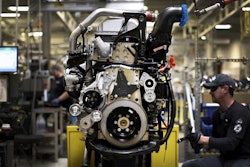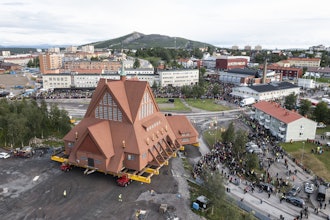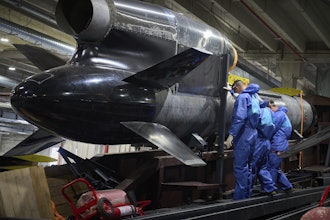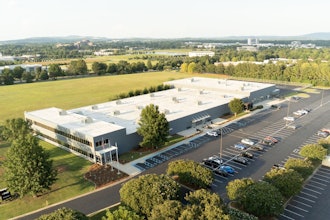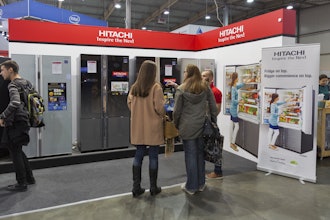
“Building Smarter Manufacturing With The
Internet of Things (IoT)”
Part 2. of “The IoT Series”
January 2014
Lopez Research LLC 2269 Chestnut Street #202 San Francisco, CA 94123 T (866) 849-5750 W www.lopezresearch.com
Manufacturing: IOT and the Next Industrial Revolution
Since the Industrial Revolution, manufacturing has been transformative
for countries and companies. In 2012, the World Economic Forum published a
research report titled “The future of manufacturing: Opportunities to drive
economic growth.” The research stated, “manufacturing has been immensely
important to the prosperity of nations, with over 70% of the income variations of
128 nations explained by differences in manufactured product export data alone.”1
In 2012, The Economist claimed we are entering the third industrial revolution,
which is based on the digitization of manufacturing2. Others refer to this as
“Smarter Manufacturing”.
According to a December 2013 survey by the American Society for
Quality (ASQ), only 13 percent of the manufacturers surveyed said they use smart
manufacturing within their organization. Of those organizations that claim to have
implemented smart manufacturing, 82 percent say they have experienced increased
efficiency, 49 percent experienced fewer product defects and 45 percent experienced
increased customer satisfaction.3
The development and adoption of the Internet of Things (IoT) is a
critical element of smarter manufacturing. Though manufacturing companies have
been implementing sensors and computerized automation for decades, the sensors,
Programmable Logic Controllers (PLC) and PC-based controllers and management
systems are largely disconnected from IT and operational systems. These systems
are organized in hierarchical fashion within individual data silos and often lack
connections to internal systems. There are several reasons for these legacy
structures, including significant security issues. These legacy structures differ from
the open, highly connected IP network structures that play such a large role in the
value propositions of IoT. While the transition to more open network architectures
and data sharing of IoT poses challenges in manufacturing and industrial markets,
the combination of IoT, Big Data, and M2M optimization will bring profound
opportunities.
IoT describes a system where items in the physical world, and sensors
within or attached to these items, are connected to the Internet via wireless and
wired network connections. The Internet of Things will connect and share data
from inanimate objects. IoT will also gather and transmit data from sensors
“Building Smarter Manufacturing With The Internet of Things” Copyright Lopez Research LLC 2
connected to living objects such as people, animals and plants. IoT will connect
everything from industrial equipment to everyday objects that range from medical
devices to automobiles. IoT can share this data with systems and with people. (For
more information on the definition of IoT read Part 1 of the series “The IoT
Primer”).
In the case of manufacturing, high value production equipment has been
heavily instrumented for some time in a closed, hard-wired network environment.
Industrial standard sensors, controllers and networks are expensive and upgrade
projects in existing facilities are not easy. The growth of IoT on the consumer side
has driven cost reductions in sensors, controllers, and communications through high
volume semiconductor manufacturing. However, industrial standard equipment is
constrained by a huge installed base of legacy equipment and standards.
As costs of industrial standard “smart” sensors with IP communications
and embedded controls falls, these solutions will be implemented across the whole
range of manufacturing equipment and in new areas that have not seen heavy
investment in automation, such as Balance of Plant4 (BoP) equipment and supply
chain logistics. IoT will benefit manufacturing companies by collecting data from
these sensors and communicating that data to factory floor workers, plant managers,
software systems and many aspects of the supply chain.
Where’s The Value In IoT For Manufacturing?
Bosch, a German manufacturer of consumer and industrial products,
refers to the next wave of manufacturing with IoT-enabled systems as Industry 4.0.5
Stefan Ferber, Director for business development of the IoT at Bosch Software
Innovations, said “Industry 1.0 was the invention of mechanical help, Industry 2.0
was mass production, pioneered by Henry Ford, Industry 3.0 brought electronics
and control systems to the shop floor, and Industry 4.0 is peer-to-peer
communication between products, systems and machines.”6
The basic principle of Industry 4.0 is the essence of IoT and smart
manufacturing. By connecting machines, a manufacturer can create intelligent
networks along the entire value chain that communicate and control each other
autonomously with significantly reduced intervention by operators. Bosch, GE and
Johnson Controls describe an IoT-enabled vision where machines predict failure
“Building Smarter Manufacturing With The Internet of Things” Copyright Lopez Research LLC 3
and trigger maintenance processes autonomously rather than relying on unreliable
monitoring by maintenance personnel. Another IoT example is self-organized
logistics that react to unexpected changes in production, such as materials shortages
and bottlenecks. Manufacturers will use technology to deliver dynamic, efficient, and
automated manufacturing processes. IoT delivers new value by connecting:
• People. Connected sensors will provide an unprecedented level of visibility into
the factory operations and supply chain flow in a much broader range of
manufacturing than just the very high value processes currently enabled. IoT in
manufacturing will improve business by connecting people to the right
information, over the right device at the point of need and cross company
boundaries to include suppliers, maintenance partners, and distribution chains.
New mobile-ready software will allow plant managers to have access to data
such as equipment efficiency, line efficiency, data visualization tools and alerts
from any location at much lower costs than previous custom systems.
• Process. In the first phases of IoT deployments, manufacturers will seek
visibility into specific visibility and supply problems. Manufacturers may deploy
these systems of use third party managed solutions to get started. As IoT
becomes more pervasive, manufacturers will enable faster information flow,
faster decisions, and greater market responsiveness by connecting devices into
both operational and business software processes. Machine to machine (M2M)
communications will enable new levels of automation. For example, GM uses
sensor data to decide if it’s too humid to paint an automobile. If the system
defines the conditions are unfavorable, the automobile will be routed to another
area of the manufacturing process, reducing repainting and maximizing plant
uptime. This change alone saved the company millions of dollars.
• Data. Mobility and the IoT will change the types of devices that connect into a
company’s systems and these newly connected devices will produce new types
of data. IoT will connect physical items such as sensors, actuators, video
cameras and RFID readers – to the Internet and to each other. Big data
processing and analytics, either on-premise or in the cloud, will collect and
analyze data from IoT-enabled devices. These solutions will turn data into
context that can be used to help people and machines make more relevant and
valuable decisions.
“Building Smarter Manufacturing With The Internet of Things” Copyright Lopez Research LLC 4
What It Means For Your Business? IoT Manufacturing Use Cases
IoT impacts every business, but has the ability to radically transform
industrial businesses such as manufacturing, utilities and aviation. There will be an
exponential number of machines and devices that will transmit both large and small
amounts of data. Smart manufacturing companies will use analytics to enact smarter
decisions and more efficient operations. IoT, big data analysis and IP networks will
help manufacturers prolong their asset lifespan while simultaneously optimizing
efficiency and minimizing energy consumption. Smart manufacturing systems will
link production and business domains such as Material Requirements Planning
(MRP), Manufacturing Resource Planning (MRPII) and Manufacturing Execution
Systems (MES). There are many potential business use cases for IoT in
manufacturing. Several examples of process improvements that IoT can impact
include:
• Factory visibility. IoT data and IP networks will connect what’s happening on
the factory floor to enterprise-based systems and decision makers. IoT will
provide production line information to decision makers and improve factory
efficiency. For example, a plant manager walking the production floor could also
use IoT and visibility tools to access the efficiency of each machine, view
production from any location, and reduce the time to decision and action. For
example, GE mobile-enabled SCADA applications allow tablets to display
performance data and status updates traditionally available only on PCs.
Instead of being chained to a control room, facilities managers and
production personnel will have easy access to real-time information and
collaborate more effectively. Mark Bernardo, the general manager of automation
software for GE Intelligent Platforms, says “When you equip people with
mobile technology, you can dramatically shrink the delta between when a
problem occurs and when it’s acted upon. If there’s a quality control problem in
a production line, they can shut down the line before it continues to create
products that will all be waste.”7
The benefits of visibility will extend beyond the enterprise to a wide
range of suppliers and third party providers of services, consumables and
capital goods. IoT systems will enable extensive involvement by third party
suppliers in the direct operations and maintenance of manufacturing plants with
“Building Smarter Manufacturing With The Internet of Things” Copyright Lopez Research LLC 5
new service and supply business models based on increased visibility and remote
monitoring. Suppliers of capital equipment may now be able to offer business
models that involve production based revenue rather than capital equipment
sales if equipment can be monitored sufficiently for both output and
maintenance status. Parts, services and consumables suppliers within
Maintenance, Repair and Operations (MRO) will use IoT to monitor distributed
inventories, tank levels of process fluids, wear parts conditions, and production
rates. This will create entirely new and very closely linked business relationships
between manufacturers and their suppliers.
• Automation. Plant networks have been isolated from each other and from local
and distant business networks. Today, we can use IoT and IP Networks to
connect everything within a plant and provide connectivity and information
sharing across multiple locations and business networks. Once machinery and
systems are connected within the plant, manufacturers can use this information
to automate workflows to maintain and optimize production systems without
human intervention. One example of this is Harley-Davidson’s use of IoT in its
York, PA motorcycle plant. The company installed software that keeps a record
of how different equipment is performing, such as the speed of fans in the
painting booth. The software can automatically adjust the machinery if it detects
that a measurement – such as fan speed, temperature, or humidity – has
deviated from acceptable ranges8.
• Energy management. In many industries, energy is frequently the second
largest operating cost. But many companies lack cost effective measurement
systems and modeling tools and/or performance and management tools to
optimize energy use in individual production operations, much less in real-time
across multiple operations, facilities, or an entire supply chain. There are
numerous ways that IoT and automation of environmental controls such as
HVAC and electricity can create cost savings for manufacturers. Connected
energy solutions can provide peak demand charge avoidance and enable
economy model operations. Certain IoT-enabled HVAC systems also offer
integrated weather data and prediction analysis to help manufacturers
understand expenses and plan energy usage. GE says efficiency improvements
of 5% in a small industrial power plant generating 15MW can save over
$200,000 on average per year.
“Building Smarter Manufacturing With The Internet of Things” Copyright Lopez Research LLC 6
• Proactive maintenance. Manufacturers have widely accepted the concept of
preventative and condition-based monitoring but many are still in the process of
implementing these programs. Lower cost sensors, wireless connectivity and big
data processing tools make it cheaper and easier to collect actual performance
data and monitor equipment health. If the manufacturer has equipment that’s
supposed to operate within a certain temperature range, the company can use
sensors to actively monitor when it goes out of range and prevent malfunctions.
Measuring vibrations to detect out of spec operations is another example.
Businesses, particularly industrial businesses, lose money when equipment fails.
With new sensor information, IoT can help a manufacturer improve overall
equipment effectiveness (OEE), save money by minimizing equipment failure
and allow the company to perform planned maintenance.
• Connected Supply Chain. Just in time manufacturing isn’t a new concept, but
IoT, analytics and IP networks will help manufacturers gain a better
understanding of the supply chain information that can be delivered in real-
time. By connecting the production line and balance of plant equipment to
suppliers, all parties can understand interdependencies, the flow of materials,
and manufacturing cycle times. IoT enabled systems can be configured for
location tracking, remote health monitoring of inventory, and reporting of parts
and products as they move through the supply chain, among many other things.
IoT systems can also collect and feed delivery information into an ERP system;
providing up-to-date information to accounting functions for billing. Real-time
information access will help manufacturers identify issues before they happen,
lower their inventory costs and potentially reduce capital requirements.
How to Get Started: Laying The Foundation For IoT in
Manufacturing
There are at least four technology elements that provide the foundation for smart
manufacturing. These include (but are not limited to):
• Network. Cisco research states only 4 percent of the devices on the
manufacturing floor are actually connected to a network. Many manufacturers
have used proprietary networks in the past. A smart manufacturing environment
requires a standardized IP-centric network that will enable all devices within a
“Building Smarter Manufacturing With The Internet of Things” Copyright Lopez Research LLC 7
plant to communicate to both operational and enterprise business systems. A
standard IP network also makes it easier to connect and collaborate with
suppliers and customers to improve supply chain visibility. Manufacturers need
robust networks that can cope with RF challenges in the plant, harsh
environmental conditions and reliability for transmission of alarms and real-
time data stream processing. For example, GM implemented a standards-based
network architecture, called the Plant Floor Controls Network (PFCN), to
standardize the design of each plant network and establish a single engineering
team that monitors and troubleshoots network operations globally. PFCN
helped GM reduce network downtime by approximately 70%9.
• Security. IT security was the most oft-cited obstacle to setting up smart
factories. Operations managers need to ensure that safeguards are built into the
solution including security procedures such as hardware encryption, physical
building security and network security for data in transit. The network must also
allow secure remote access to systems. Security and networking solutions must
also be engineered to withstand harsh environmental conditions, such as heat
and moisture, that aren’t present in typical networks. Identity and authentication
structures will also need to be updated to support “things” as well as people.
• Software systems. Today’s IoT data is different than the data we use to operate
our systems. It requires collecting a wide range of data from a variety of
sensors. These software systems and models must translate information from
the physical world into actionable insight that can be used by humans and
machines. For example, Toyota is using Rockwell’s software for real time error
corrections in the plant. With improved troubleshooting capabilities and error
correction, Toyota has minimized rework and scrap rates in its Alabama plant,
which has resulted in an annual cost saving of $550,000.10
• Big data and analytics. While manufacturers have been generating big data for
many years, companies have had limited ability to store, analyze and effectively
use all the data that was available. New big data processing tools are enabling
real-time data stream analysis that can provide dramatic improvements in real
time problem solving and cost avoidance. Big data and analytics will be the
foundation for areas such as forecasting, proactive maintenance and automation.
Conagra Mills makes 800 different kinds of flour for its customers. It uses
“Building Smarter Manufacturing With The Internet of Things” Copyright Lopez Research LLC 8
predictive tools and services to forecast pricing, capacity requirements and
customer demand. This allowed the company to maximize revenues through
improved margin decisions and increase production capacity utilization by 5%.11
Conclusion
Where are we headed? IoT will fundamentally change how products are invented,
manufactured, shipped and sold. Leading manufacturers are designing for constantly
evolving, evergreen products and services. It requires a completely new approach to
designing products as well as factories and systems that support a manufacturing
process. With IoT, IP networks and analytics, manufacturers can become more
efficient, improve worker safety and offer new business models. IoT will help
manufacturers improve resource efficiency, safety and return on assets.
Manufacturers that master this new dynamic will have a variety of new
opportunities for revenue growth and cost savings.
ALL RIGHTS RESERVED. LOPEZ RESEARCH LLC
The development, preparation, and publication of this work have been undertaken
with great care. While we don’t anticipate any errors in this document, errors may
occur. We’ll make every attempt to correct any errors that are found. The publisher
is not responsible for consequences that may ensue from use of materials or
information contained in this work. No part of this document may be reproduced
in any manner without the express written consent of Lopez Research LLC, except
in the case of brief excerpts in critical reviews and articles. This document is
available for reprints. To purchase syndicated research or reprints of the report
please email or call us at: [email protected] or (866) 849-5750
About Lopez Research
Lopez Research, founded in 2008, is a market research and strategy consulting firm
that specializes enterprise mobility, Internet of Things, and context-aware services.
Its main research theme is o“Right-time Experiences”, which are design
applications, services and experiences that deliver the right information or service at
the point of need. The company’s mission is to understand the evolution of these
trends, provide thought leadership, and assist its enterprise and technology vendor
clients in building winning market strategies. Lopez Research combines survey-
“Building Smarter Manufacturing With The Internet of Things” Copyright Lopez Research LLC 9
based research and predictive analysis to gain insight into coming trends. The
company provides clients and readers with the bridge between business leadership
and technology adoption. www.lopezresearch.com
Endnotes
“Building Smarter Manufacturing With The Internet of Things” Copyright Lopez Research LLC 10
1 http://www3.weforum.org/docs/WEF_MOB_FutureManufacturing_Report_2012.pdf
2 http://www.economist.com/node/21553017
3 http://www.prweb.com/releases/2013/12/prweb11430148.htm
4 The "balance of plant" of a system is the components not included in the primary system itself, including
blowers, compressors, pumps, and other necessary (but not primary) components.
5 http://www.bosch-si.com/solutions/manufacturing/industry-4-0/industry-4-0.html
6 “The Internet of Things business index: A quiet revolution gathers pace.”
7 http://www.biztechmagazine.com/article/2013/12/united-airlines-and-ge-make-room-mobility
8 http://online.wsj.com/news/articles/SB10001424127887324059704578472671425572966
9 http://www.cisco.com/web/strategy/docs/manufacturing/Cisco-AutoCaseStudy-GM.pdf
10 http://www.industryweek.com/blog/how-will-internet-things-help-manufacturing
11 http://www.ibm.com/smarterplanet/us/en/leadership/conagra/




